#food production
Text
Hiii friends!! I'm currently writing a thesis and it would mean the world to me if you helped me out by taking this survey:
Please inform me if you find any grammatical or semantic errors!! If you have any questions, you can always write me in my DMs. Reblogs are very appreciated!! (I'm going to reblog this post several times, so you're welcome to block one of the tags, I understand that it may be annoying)
53 notes
·
View notes
Text
It's so weird how meat-forward American food culture is that Americans who don't eat meat every day will say to me "yeah I'm basically vegetarian I don't eat meat *every* day" like????? Please I'm begging you to consider other forms of protein the human body is not meant to only eat meat, we are omnivores.
Like. It was honestly pretty easy for me to switch to a vegetarian diet because I grew up in a kosher household and kosher meat is *expensive* so we only had meat on Shabbat (once a week). But then I'll talk to other Americans and they'll talk about eating meat every day and I'm like??? How???
I think humans are meant to eat meat and I think expecting everyone to give it up is wrong, but c'mon this is not sustainable you do not need to be eating meat every single day.
Why is America so meat obsessed?????
#food anthropology#food production#american food culture#meat industry#if I had the time I'd answer my question and the answer would be the legacy of colonialism and displacing indigenous#to make way for cattle pastures
63 notes
·
View notes
Text
Closing Loops in Soilless Gardening - Hydroponics and Aquaponics
What is the future of food production going to look like? Is the projected 10 billion people in 25 years, out of which two thirds will live in cities, going to require us to convert every square meter of arable land into intensive mono cultural farms? Please don't let that be true! There HAS to be some alternative. Fortunately, there are several. Two of them are different ways of growing plants without soil, a radically new method, which may be most appealing to urban food production.

image source
Hydroponics: Growing Plants in Water
When it comes to growing large amounts of food on a small area efficiently, hydroponic systems are often brought up as a solution. And the reasons sound pretty convincing: An efficient hydroponic farm uses 90% less water, and can yield 3-10 times the amount of produce per area, with 7-14 growth cycles in a year. IMPRESSIVE! But before getting too excited, let's not forget: the devil is in the details! It's worth looking into under exactly what conditions those plants grow, being fed by what light, and most importantly which nutrients, and where they come from.
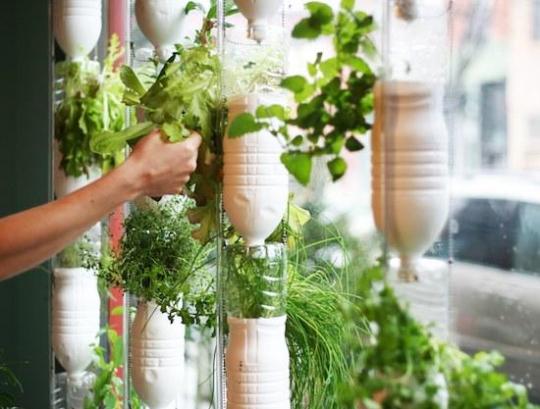
image source
The basic concept, however, of growing plants vertically, in mostly water, with some kind of substrate, such as clay balls or vermiculite, is actually a pretty nifty way to grow food where there are no fields. The most basic form of this may be the Windowfarm technique, which I experimented with myself years ago in my Budapest apartment. Going to Shanghai, the whole idea seems to be taken to a whole new level.
https://static.dezeen.com/uploads/2017/04/sunqiao-urban-agricultural-district-Sasaki-architecture-industrial-china-shanghai_dezeen_hero-b.jpg
image source
Is That Really Sustainable? Or Even Healthy?
… not to mention, does hydroponics even fit into Permaculture? Because let's be honest: with a system that needs to be constantly managed and monitored you could not be further from a self-supporting ecosystem. Also, what exactly do those plants get to eat? The typical N-P-K made industrially out of petrochemicals? Most likely. So while it certainly reduces the transport related drawbacks, hydroponics is by no means energy efficient, and the nutritional value won't be any better than your most industrially grown veggies.

image source
How Does Aquaponics Compare?
Okay, so let's bring in the fish! For those not familiar with the difference between the two systems, aquaponics is the combination of hydroponics and aquaculture, which are simply fish farms. Having fish in a tank, they will naturally defecate into the water, requiring it to be changed regularly. Plants, however love to eat those nutrients that the fish excrete. Or to be more exact, they feed on the nutrients that have been converted by bacteria and other microbes. The ammonia will turn in to nitrites, which in turn become nitrates, that is food for the plants.
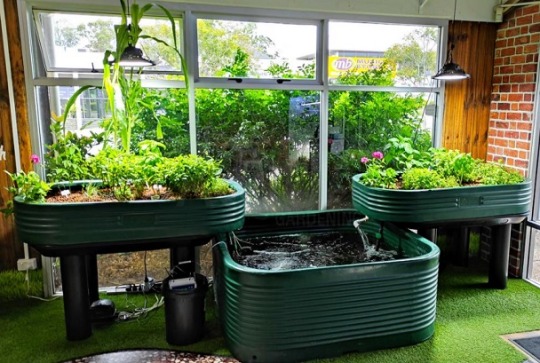
image source
So running the water from the fish through the plants growing substrate will on one hand feed the plants, as well as clean it for the fish to enjoy it again. So the system already closed a few loops there, making it more sustainable than just mere hydroponics. Also, the inclusion of microbes already offers a more diverse environment, bringing the system a bit closer to an ecosystem. But let's not get ahead of ourselves: Aquaponic systems still need close monitoring, as they are still a far cry from a self sustaining ecosystem of let's say a pond. Also, the water circulation / aeration is most likely going to require a pump, and depending on the exact setup of the system, maybe artificial lighting for the plants. All these aspects add to the energy requirement of the aquaponic system.
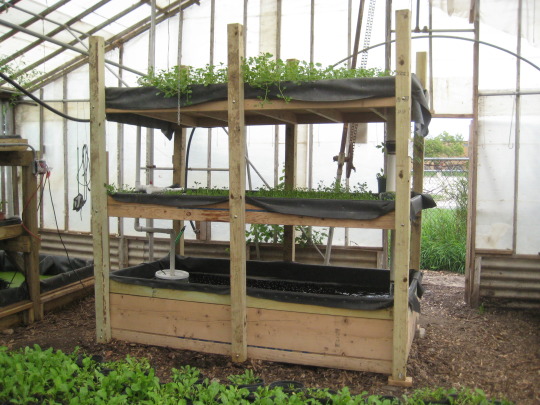
image source
A Truly Closed Loop? Consider the Food of the Fish!
When praising the sustainability of aquaponics, one thing that mustn't be ignored is the source of the fish food. Just like with the hydroponic systems, where the food for the plants or the fertilizer is considered, we can't ignore the feed we give to our fish to eat. If it is the same industrial feed, we may as well have kept to our hydroponics. Not true, since including fish already makes our system more diverse. So instead, let's continue in that same direction. What do fish eat? What is good for them? How can we grow that food ourselves?

image source
Making Your Own Sustainable Fish Food
Here I could probably start a number of individual posts, since talking about fish food is like opening up a can of worms. But fortunately, I already have a number of appropriate things written. Talking about worms, by the way, anyone who has been fishing knows that they are a favored delicacy, and anyone who composts will have no shortage of them. Since worms are mostly vegetarians, and many of us eat meat, it may have been a bit difficult to properly compost greasy, meaty, bony food wastes. That's where black soldier flies come in, whose larvae are also frequently mentioned for fish food. I still need to try growing those guys. As for green plants for the fish, duckweed makes also good fish feed, again something I have no experience with. What I do know, though, is spirulina, which is also super rich in nutrients, and I would be surprised if the fish didn't like it. So I can see throwing some composting worms, black soldier fly larvae, and spirulina into a blender, to make some great nutritious fish food. At the moment this is very theoretical for me, though.

image source
Don't Give Up the Soil Completely
So does this mean we should all focus on setting up our most sustainable fish-plant-compost combo cycles? Hells yeah! But please not at the expense of everything else! Soilless gardening, as exciting and revolutionary as it may sound, is still that: without soil. And let's face it: neither us, nor our beans and tomatoes, have evolved to live entirely without soil. That just seems wrong. Even in a small urban apartment it's worth having a bit of soil on your roof, balcony, or window sill, where you can dig your hands into a world of healthy microbial diversity on occasion. And if you do have the space, by all means, set up a pond, a dam, or another aquatic ecosystem, where fish, and frogs, and dragonflies, and numerous other species can live together without relying on our management. Apart from looking pretty, they will also provide food for us, that is nutritionally superior to anything industrially grown.
Sources: 1, 2, 3, 4, 5, 6, 7, 8
115 notes
·
View notes
Text
Butchering
Referenced nightmares, referenced therapy, referenced animal death [meat production], implied past trauma, an aro(?)ace’s poor understanding of romantic/sexual attraction
[Follows Session #1]
Deitelbaum’s was a good place for East to start. It was usually quiet and slow paced, and Joshua - the manager - knew the Holloway Home well. Alister had been working there for months, and was more than happy to help train East. (It was only a matter of time before he moved on to a more permanent job - or at least, one he could pay his own rent with - and Joshua could use the extra hands.)
“Any questions about the slicer?”
“How often is it fully disinfected?” East had surprisingly good questions, as focused and serious as he was doing chores around the house. Alister was relieved Nate agreed it was time the guy got a job - he needed something to throw himself into other than dusting the common room or sorting the laundry.
“He always like this or just first day nerves?” Joshua happened to be there that morning, both to meet East and drop off meat fresh from the butcher. East was currently prepping the cutting boards, brow furrowed and eyes intense as he worked. Alister doubted he even heard them talking about him here at the front of the deli.
“You can see why Nate needed him out of the house - he’s just the same doing chores and stuff at home.” Tierney leaned against the counter, yawning. The sun wasn’t quite over the horizon yet - the deli would open soon, but they probably wouldn’t see customers for another hour or two.
“He’s a good worker.” Alister affirmed, taking a parcel of beef from Joshua. The older gentlemen looked…skeptical wasn’t the right word, perhaps politely concerned?
“Don’t let him over work himself - last thing we want is someone getting hurt.”
“We’ll keep an eye on him, don’t worry J.”
Joshua gave a long suffering look to Alister; Tierney wasn’t the pinnacle of professionalism, but he worked well with the customers. Alister sighed, glancing back at East - hair tied back and stuffed under a hairnet, gloves and apron spotless.
“I’ll let you know if there are any problems.”
—
East was a quick learner, which Alister was thankful for. He didn’t expect so many customers today - was there a holiday coming up he had forgotten? His second guess was that there was a wave of tourists passing through; he didn’t recognize many of the people in the deli.
Things were starting to calm down at the registers, enough that Alister considered stepping back to help East prepare the orders, when a new customer stepped up to the counter. Alister glanced at her and smiled, but his heart had already started to sink.
He had seen a few new immigrants come to the kosher deli, but Joshua usually handled their orders. So when the veiled older woman started to speak, Alister felt embarrassed guilt creep onto his face. He didn’t understand her - but he could tell she was pointing to the lamb behind the counter, and her tone was questioning. Both their frustrations were starting to rise when, to Alister’s surprise, he heard East’s soft rumble behind him.
“She’s asking how it was slaughtered.”
Alister nearly jumped, muttering a curse to himself. East was so quiet for such a large man, a silent shadow hovering over his shoulder.
“Oh. Uh - can - can you tell her it’s kosher, Joshua picks it up from the butcher.” Alister wouldn’t admit he was impressed by the sudden ease in East’s tone as he replied to the woman, the two having a brief back and forth. East’s face was uncharacteristically relaxed, tone almost confident - though, Alister couldn’t be sure, seeing as he didn’t understand the language.
“It’s halal too, right? No blood, killed clean?”
“Yes? Yes - I’ve seen them butcher sheep there.” Alister glanced back at he woman, embarrassment bleeding to curiosity. There were more and more Muslim immigrants with each passing year, but he should have guessed by her headwear she wasn’t Joshua’s usual foreign clientele.
Eventually it seemed East and the woman reached an agreement, and he translated her order to Alister before going to the back and preparing the meat. It was a bit later, during a lull when the shop was quiet, that Tierney dare broach the subject. It was their lunch break - the closed sign temporarily flipped while the three enjoyed a moment’s peace and some prepacked food in the store room.
“Why the hell didn’t you mention you were bilingual? Trying to get out of register work?” Tierney had wolfed down his lunch in minutes, idly waiting for the others to finish.
“Didn’t think it was relevant to cutting up meat.” East mumbled, eating his own sandwich in small bites as though savoring the blandness of ham and cheese.
“Where the hell’d you pick that up? You’re German, ain’t ya?”
“Work.” East stiffened, almost imperceptibly, but Alister could see his grip on the soft bread tighten.
“Right, soldier and stuff - damn. Figured you might know a few phrases and shit, not, like, be fluent.” Tierney rambled, but Alister quirked a brow at the revelation. Military certainly seemed to fit the way East carried himself. (And it could explain the nights Al lay awake praying that the poor bastard would sleep soundly for both their sake’s.)
“Nate never mentioned - ”
East cut him off, words clipped and cold.
“No. He didn’t.”
Alister winced at his tone, eyes flickering between East’s eyes and the floor. He didn’t seem angry, but he did seem agitated. On edge.
“Oh, sorry mate I didn’t mean to - “
“It’s fine. Just don’t like talking about it.”
The quiet that followed wasn’t the most uncomfortable silence Alister had sat through, but it was getting close.
“Thanks, by the way. For jumping in when you did. Worst thing when working the front is telling a customer no.” Alister sighed, cracking open a bottle of coke. Some tension seemed to bleed from East’s shoulders.
“No problem.”
—
A few days later, the woman was back, and East wasn’t there. (Alister almost regretted suggesting Nate find him a therapist - nightmares be damned he did not want to turn this sweet old lady away just because he couldn’t understand her.) But this time, she wasn’t alone.
There was a younger woman with her, and for a brief moment, Alister forgot his anxieties. He had known his fair share of beautiful women - he had childhood crushes, unreciprocated flirting, and a few short lived trysts. But he had to admit, this attraction was new. He couldn’t see the shape of her legs, hidden in the folds of a long black skirt, or the curve of her chest, hidden behind the thick plush of a winter coat. Ever her hair, wrapped and covered in a simple purple headscarf, was hidden from him.
And while he could see her soft lips, her dark eyes - that was not what enraptured him. It was her poise, the grace and confidence with which she carried herself. Like royalty, or a soldier leading the charge. He almost didn’t realize she was already standing at the register, speaking to him.
“Excuse me? Sorry, I’m not sure if you recognize her - my mother - “
“Yeah. The - the lamb the other day. I remember her.” Alister gave a shy smile to the older woman, who was muttering in her own language to her daughter. She glanced back at her mother, an embarrassed smile of her own creeping onto her face.
“Well, we just wanted to thank you - the lamb was amazing and she wanted to let you know she’ll be buying whatever meat she gets from here from now on.”
“Oh - oh it’s, it’s my job, ma’am - “
“Jasmine; my mother is Hanan.”
“Ah, well, nice to meet you both. Um, I’m Al.”
“So your name tag says.”
“Oh - right. Right, ah, well East - he was the one that helped, uh, translate between us - he’s not here today but I’ll be sure to pass it in to him. That you’re grateful.”
“We’d appreciate that.” Jasmine’s eyes were laughing at him, and Alister knew a blush was flushing his face pink. Why was he such a dunce all of a sudden?
Hanan whispered something to her daughter, and - he probably imagined it - but he swore Jasmine’s cheeks seemed to warm as her eyebrows shot up in surprise before she muttered a reply he didn’t understand.
“Well, um, we’ll take the same order as last time - please.”
“No problem, Tierney over there will ring you up and I’ll - I’ll get right to it.”
—
“You have no game. When was the last time you talked to a bird?”
“Can it, O’Hare.”
[Before Unlocked Cage]
(Part of my Freelancers: Changing Tides series)
Taglist: @stargeode @sacredwrath
#whump#recovery#nightmares#therapy#past trauma#animal death#food production#freelancers#no proofreading we die like Elias. strangled by the hand of our brother to escape hell the only way we know how.#listen. listen this subplot is important even if idk how to cleanly introduce it.#coming to terms w the fact that I’m more aro than I thought. wtf is a crush supposed to be like???#whatever. East works in a deli. Alister has a crush on a hijabi customer. tierney is a little shit. let me project on all my ocs pls.
7 notes
·
View notes
Text

International Harvester - the peacemaker of progress.
#vintage illustration#international harvester#harvester#tractors#food production#wwii history#wwii era#wwii#ww2 history#ww2#ww2 art#world war ii#world war 2#the 40s#farming
12 notes
·
View notes
Text
It was 1 kg and became 2 kg of meat.
Russian food producers are deceiving their customers
7 notes
·
View notes
Text
[...]
Del Monte’s 80 sq km plantation sits on the border of Murang’a and Kiambu counties, about 40 kilometres northeast of Nairobi, in a landscape marked with lush green vegetation and rich red soil. The area is also blighted by poverty, unemployment and drug use. This deprivation is despite the money generated by Del Monte, whose pineapple exports earned the country’s economy more than $100m in foreign exchange in 2018. This financial firepower has provided the company with political clout.
Among local villagers, the vast farm is often described as kwa guuka, meaning “our grandfather’s”. It is a bitter reference to the fact that many families were forcefully evicted from the land when it was first acquired by the company’s predecessor several decades ago.
The farm is the single largest exporter of Kenyan produce to the world. This huge global operation means that, although countless pineapples are grown in the area every year, virtually the only ones sold locally are those that have been stolen from the farm.
“The boys around don't have anything much to do, and they need money for their survival. So the easiest way is to go and raid the farm, get the pineapples and sell to the public,” says Joel. “Mostly it's driven by peer pressure and poverty.”
These conditions stand in stark contrast with the lifestyle enjoyed by the 237 guards employed by Del Monte at the farm, who have fully serviced schools, hospitals and sports grounds on company premises.
[...]
14 notes
·
View notes
Text
Floods, droughts and panic attacks: Climate change is taking its toll on Europe's farmers | Euronews
10 notes
·
View notes
Text
I keep seeing posts talking about veganism and honey and how honey is vegan and people should stop whining about any issues that it may present.
But, as a beekeeper and an ecologist, it really isn't that black and white and it varies on which country you are talking about.
US.
In the US, there are actual issues with bee welfare. This doesn't come from the honey removal but instead, stems from the massive issue of monocultures.
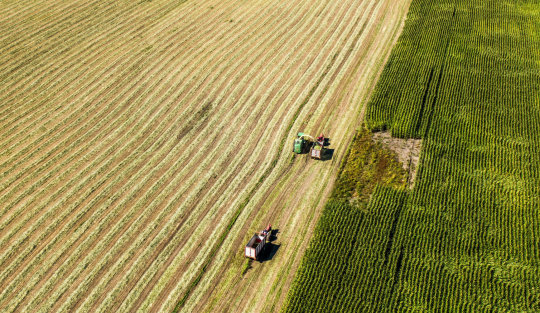
Monocultures like this, make it difficult for the bees to pollinate because they get really tired of eating the same kinds of nectar.
Because of this. American beekeepers came up with the solution of Bee roadtrips! And this is where the problems really come from here:
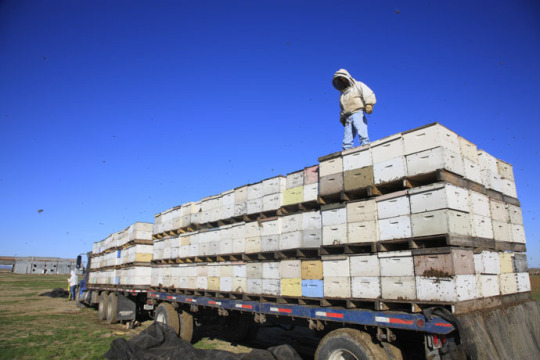
This issue with this is bees aren't built to be shipped around. And because there are so many stretches of land without food for them, their keepers have to feed them, which is incredibly unhealthy for them, and is an issue for their welfare.
UK.
Welfare of honey bees isn't the only issue here. In the UK, our honey bees are outcompeting our native pollinators like Bumblebees and solitary bees


This means industrial levels of farming honey bees are driving the populations of our other bees down.
This is an issue because A. Diversity in species is really great! And B. Honey bees are shit pollinators in comparison to the other species, so this also hurts our crops and flowers.
Conclusion.
I'm not by any means saying don't eat honey. Honey is fantastic and is one of the few animal products that is okay harvesting from bees. But also it's worth thinking about the consequences.
Though these issues can be avoided by avoiding buying from large scale corporations. Etc, instead go to local beekeepers. And Education is super duper important, rather than simply assuming there are no issues with it!
Thank you for coming to my silly little biology talk!
#bees thoughts#beekeeping#honey#veganfood#thoughts#i love bees#save the bees#food production#rambles#animals#insects#planet#environment
97 notes
·
View notes
Text
Wouldn't it be marvellous if all the world's growers could think of growing today's food as nurturing the soil ready for next year's harvest?
"Soil: The incredible story of what keeps the earth, and us, healthy" - Matthew Evans
#book quote#soil#matthew evans#nonfiction#wouldn't it be nice#marvelous#farmers#growers#food production#nurturing#harvest
4 notes
·
View notes
Text
With projected food shortages now is the time to plant Chaya Tree Spinach and other edible perennials.
The 3m high Chaya Spinach Tree Chaya Tree Spinach (Cnidiscolus chayamansa) is a fantastic and abundant food.
Chaya leaves do need some cooking preparation as do Cassava leaves and Warrigal Greens. Wikipedia states up to 5 raw leaves a day can be eaten but other sources are more cautious. Although blending and drying also seems to remove the toxic hydrocyanic acid substances, boiling for 20 minutes is recommended. The leaves survive the boiling still looking green and attractive. The broth that is left can also be consumed as the toxic substances have been destroyed by the heat.
Cooking in aluminum cookware can result in a toxic broth, causing diarrhea.[13]
Tasty green leaves are used as a spinach or chard substitute or can be used in a salad and smoothies.
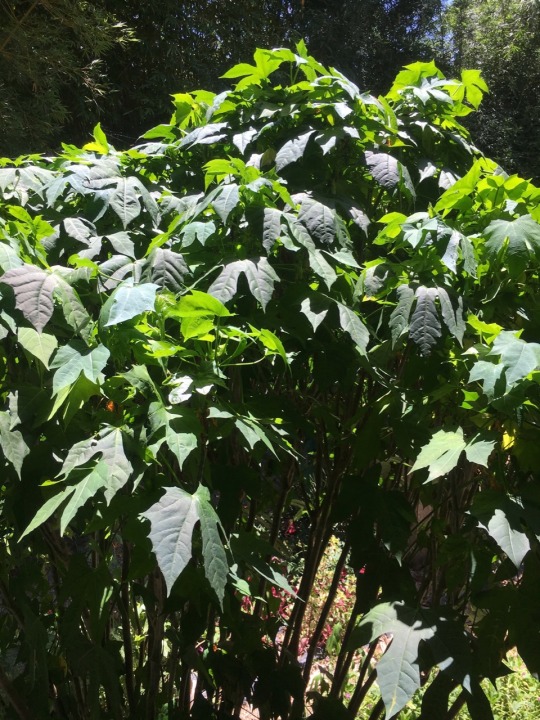
Chaya is a good source of protein, vitamins, calcium, and iron; and is also a rich source of antioxidants.[10]" Wikipedia
The plant does burn off a little from cold but seems to survive well in a microclimate in a warm temperate-subtropical climate. There are reports that Chaya will regrow from the root after frosts. In colder climates try growing in a greenhouse.Leafless stem cuttings are best left to dry and callus before potting up. Keep the cutting reasonably dry to avoid rotting.
The Chaya Spinach Tree (a large bush) fits well into a vegetable patch. It takes up a small ground footprint and provides some shade to other vegetables).

#food security#Chaya#Tree spinach#Cnidoscolus aconitifolius#climate change#jail climate criminals#climate criminals#qihou bianhua#changement climatique#klimawandel#klimakatastrophe#cambio climático#grow your own food#foodshortages#food production#food insecurity#food
24 notes
·
View notes
Link
Excerpt from this story from Grist:
Vicious heat waves are sweeping parts of the globe this week, along with the dangers that come with blazing-hot temperatures: wildfires, dehydration, and even death. The hot weather could also push prices up for food, making inflation even worse.
Western Europe is facing sweltering temperatures again this week, with the thermostat hovering around 110 degrees in Seville in southern Spain. More than 20 wildfires are burning in Spain and Portugal, and persistent drought has left rivers and reservoirs running so low that they’re exposing ancient artifacts.
In Italy, the hot and dry conditions are expected to destroy a third of the seasonal harvest of rice, corn, and animal fodder — at a minimum. Locusts have descended on the island of Sardinia in the worst invasion in three decades, hurting the production of hay and alfalfa. The European Commission recently downgraded its soft-wheat harvest estimates from 130 million tons to 125 million tons — more bad news amid a food shortage precipitated by Russia’s blockade on exports from Ukraine. (Russia and Ukraine are among the world’s biggest exporters of grain.)
Across the world in China, a record-breaking heat wave is causing major problems. Roofs are melting, residents are relocating to public cooling zones in underground air-raid shelters, and health workers are strapping frozen food to their too-hot hazmat suits. The Central Meteorological Observatory in Tokyo has warned that the heat could further hurt the production of corn and soy, worsening inflation. These crops are used to feed pigs, and early-season failures have already sent the price of pork, China’s staple meat, soaring.
When major crops wither, it can have knock-on effects across the ocean and show up on your grocery bill. Inflation has been climbing in the United States at the highest rate in 40 years, up 9.1 percent over the past 12 months, much of it the result of spiking food and energy prices. The surge has been egged on by the pandemic-beleaguered supply chain and by Russia’s invasion of Ukraine. But climate change is becoming a driver of inflation, too. Experts are warning that heat, flooding, drought, wildfires, and other disasters have been wreaking economic havoc, with worse to come.
“If we wish to control inflation, we must address climate change now,” David A. Super, a professor of law and economics at Georgetown, recently argued in The Hill. Beyond crops, the changing climate has driven up the price of lumber as well as insurance premiums.
50 notes
·
View notes
Text
@triviallytrue, @headspace-hotel
Re: this: I can't reblog the post, but "pre-Columbian North American giant wild bison herds had a similar total biomass to modern North American grazing cattle herds and converted grass to animal tissue at a similar rate" doesn't seem obviously silly to me.
Biologically, cattle are basically just more docile bison. Human selective breeding has probably made some difference to how much metabolic resources domestic cattle invest in growth vs. everything else, but cattle and bison are physiologically and structurally very similar organisms and meat is already a large percentage of a bison's mass, so I doubt it's an orders of magnitude difference. It's not like fruit, where you can easily selectively breed the plant to grow orders of magnitude bigger fruit.
There is the factor that with domestic cattle you can feed them stuff that isn't wild grass. You can feed them irrigated farmed animal feed crops extensively selectively bred for high yields that grow in monoculture fields with no competition and have their own growth supercharged by commercial fertilizers full of mined phosphorus and Haber process nitrogen etc.. That might make an orders of magnitude difference. But I have the admittedly vague impression that while modern cattle-raising does involve a significant amount of stable feeding with animal feed crops or agricultural waste, it also still involves quite a bit of basically just letting the cattle walk around the landscape and eat grass.
It's worth noting that there is at least one major biome where basically industrialized hunting is still a major modern food source for humans: the ocean. It doesn't seem crazy to imagine the same approach might work in terrestrial contexts; the oceans and the land have similar total productivity and the land is significantly more productive per average square kilometer. On the flip side, it's also worth noting that modern fishing isn't exactly a glowing model of sustainability and even there we're seeing a switch to aquaculture.
Like, I doubt "return the land to the bison and then industrially harvest them the way we harvest ocean fish" would actually be a good idea (or what Headspace Hotel actually wants to do), but it actually isn't obvious to me that it would be orders of magnitude less land-efficient than modern cattle ranching, at least in terms of meat production (a major advantage of cattle over wild bison is you can milk cattle, but we're talking about meat, so that isn't very relevant).
Now I wonder to what degree modern San Franciscan office workers eating way more meat than tenth century Chinese peasants has more to do with improvements in transport (railroads, trucks, motorized ships), food preservation (canning and refrigeration), weapons (guns and railroads enable agriculturalist states to conquer semi-arid nomad country and turn it into export-oriented meat factories), and the efficiency of specifically chicken production than with a general increase in the land efficiency of meat production.
Aside: I have no idea how realistic it is, but "basically treat bison the way we treat fish" gives me a mental image of giant vehicles that drive around the Great Plains to run down herds of bison and pull them in for efficient industrial slaughter, dismemberment, and packaging; basically exactly how fishing boats work, but on land! Giant vehicles roaming steppes and gathering up big wild herbivores for on-site slaughter and processing might be a neat idea for speculative fiction!
29 notes
·
View notes
Text
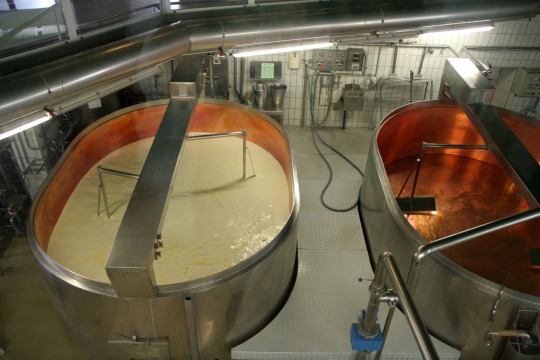
Food processing
#food processing#food production#food products#cheese#wikipedia#wikipedia pictures#food#industrial food production
36 notes
·
View notes
Text
From Pond Scum to Clean Fuel: How Algae Biofuels Are Revolutionizing Transportation
In the relentless pursuit of combating climate change and breaking free from fossil fuel dependency, the spotlight shines brightly on algae biofuels as a promising and sustainable solution within the transportation sector. These remarkable fuels are harnessed from photosynthetic microorganisms, presenting a compelling case for their potential to drastically reduce carbon emissions and pave the…

View On WordPress
#algae#biofuel#carbon neutral#clean energy#climate change#eco-friendly#energy security#food production#US Navy
2 notes
·
View notes
Photo

Label for Textang Chile Con Carne with Beans, registered 9/7/1937.
Series: Case Files for Registered Product Labels , 1874 - 1940
Record Group 241: Records of the Patent and Trademark Office, 1836 - 1978
Transcription:
FAMILY SIZE
DIRECTIONS
Submerge can in slowly boiling
water for 20 minutes. OPEN
CAREFULLY TO AVOID SPURTING.
For restaurants, church socials,
lodge dinners, and family table.
Serve three portions per tin.
Large users should keep a num-
ber of cans under simmering
water to avoid delay in serving.
This preheating does no harm to
unopened cans left over.
U. S. INSPECTED AND PASSED BY
DEPARTMENT OF AGRICULTURE
ESTABLISHEMENT No. 438
TEXTANG
TRADE MARK REG.
CONTENTS 15 OZS.
EXTRA QUALITY
CHILE CON CARNE
WITH BEANS
TRY OUR TEXTANG INDIVIDUALLY WRAPPED TAMALES EXTRA FINE
COPYRIGHTED 1937 BY RUTHERFORD FOOD CORPORATION
PACKED BY RUTHERFORD FOOD CORPORATION
KANSAS CITY, MO., U.S.A.
17 notes
·
View notes